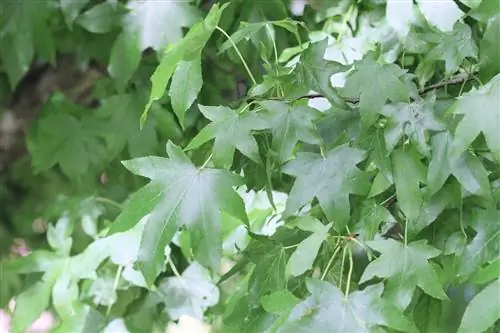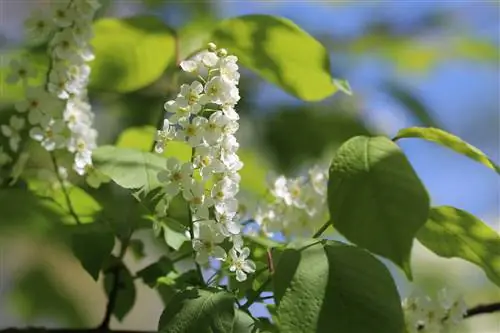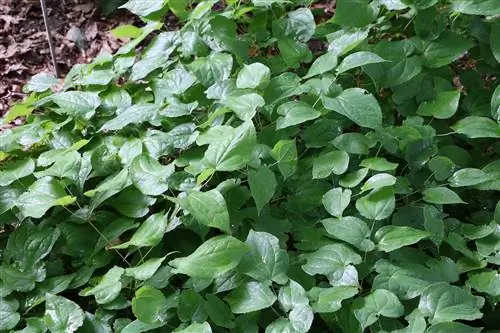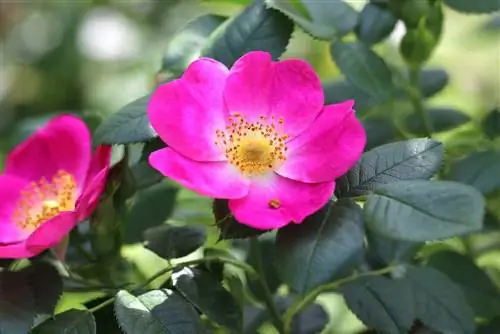- Author admin [email protected].
- Public 2023-12-17 03:39.
- Last modified 2025-06-01 06:48.
The American sweetgum or Liquidambar styraciflua is reminiscent of the well-known maple, but differs from it due to its compact dimensions. Suitable for small gardens, it requires some care and attention, at least when it is young - so hobby gardeners with little time will only enjoy it to a limited extent. But once the sweetgum tree has become established, the effort required for it is surprisingly low. The tree rewards the effort with decorative flowers, fruits and an autumn color that is second to none.
Location
The brighter the better - that is the motto of the American sweetgum tree. Its location should be in full sun, because even in light shade it can become too dark for Liquidambar styraciflua. The tree also needs a lot of warmth, especially in the first few years. Cold wind or rain, which can affect the tree unhindered, is therefore extremely unfavorable. Areas that are somewhat shielded by house walls, walls or other plants but are still very sunny are ideal. The size of the tree must also be taken into account. With a crown diameter of up to four meters, the tree requires some space and a corresponding distance from other plants.
Tip:
Due to its initial sensitivity, it is advisable to initially cultivate the sweetgum tree in a bucket. This way it is easier to protect it from the elements.
Substrate
The ideal substrate for the sweetgum tree is fresh, loamy and nutrient-rich soil. However, the Liquidambar styraciflua cannot tolerate compaction in this area, which is why some sand should be mixed in to loosen it up. To increase the nutrient content, additions of compost and horn shavings or meal are ideal.
Plants
Planting the sweetgum tree in the garden is possible in early autumn and late spring. Because young trees in particular can still react sensitively to frost and cold wind, spring should be brought forward. Then Liquidambar styraciflua still has enough time to grow and prepare for winter. The following instructions point out further special features.
- The planting hole should be at least twice as large as the root ball.
- The prepared soil mixture is used to line the planting hole.
- The roots are inserted so deep that the grafting point is just below the surface of the earth.
- Together with the tree, a stabilizing post must be used, which not only keeps the tree straight, but also helps with rooting. Of course, the trunk must be securely connected to the pole.
- After filling with loose soil, watering is carried out thoroughly.
- A thick layer of mulch can also be applied to the tree disc as protection.
Pouring
The sweetgum tree copes very well with wet soil, but not at all with dry soil. Especially in the first few years of growth, the young Liquidambar styracifluas cannot yet draw sufficiently on the reserves in the soil and therefore have to be watered additionally. That can be overwhelming. Up to twice a week in the hot and dry phases of summer. Otherwise as required. In such a way that the soil always remains at least slightly moist. When planting freely in the garden, drying out should also be avoided during the winter. Small amounts of water on frost-free days may be necessary.
Fertilize
The sweetgum tree requires comparatively large amounts of nutrients. Minerals in particular must therefore be supplemented. For a tree in surprisingly large quantities. For this purpose, mineral fertilizer is administered every two weeks from approximately May to September. If this is applied, it should be watered well afterwards. Otherwise, the roots can be damaged by excessive concentrations.
Blend
The sweetgum tree does not require any topiary, but it benefits from regular thinning. Only dead branches, damaged twigs and shoots that protrude individually from the crown or grow inward should be removed. Tapered pruning, which involves removing branch tips all around, is also possible and can promote denser growth and keep the tree compact. Autumn is a good time for more radical interventions. In the spring - before budding - only small corrections should be made. If the cut is made when shoots are already visible, the tree will remain bare in this area and will not sprout again until the following year.
Propagation
The propagation of the sweetgum tree requires some patience and the appropriate preparation of the seeds. In addition, the Liquidambar styraciflua carries a large number of non-germinable seeds in your own garden. So numerous seeds have to be planted in order to achieve success. Before the seeds can even be germinated, they must also be stratified. This means nothing other than storing them in the refrigerator for about two months or leaving them outside over the winter, because they need a cold pulse for their first shoots. They are then placed on potting soil and kept moist. They should now be kept in a bright place at around 20 °C.
Tip:
Due to the low germination rate, it makes sense to purchase seeds from specialist retailers.
Wintering
Once the sweetgum tree has grown and has been thriving in the chosen location for several years, it does not need any protection in winter. Young trees, however, do. These should be piled up with pine brushwood, straw, mulch or manure to insulate the roots. In addition, wrapping the trunk with garden fleece is recommended. In pot culture, it is advisable to overwinter the Liquidambar styraciflua indoors. Here it should be cold but frost-free and bright.
Typical diseases, care errors and pests
The American sweetgum tree is generally spared from diseases and pests. However, damage can occur due to care errors. Typical here are:
- a location that is too dark
- compacted soil
- not enough water
- missing nutrients
The Liquidambar styraciflua responds to this with poor growth, leaf loss and discoloration. The death of the tree is also not unusual, especially too little moisture.
Frequently asked questions
Is the sweetgum tree poisonous?
The American sweetgum tree is partly irritating to poisonous. The resin is harmless when processed and was even used as a base for chewing gum at times. However, children, sensitive people and animals in particular can suffer symptoms of poisoning through contact with Liquidambar styraciflua.
Can I grow Liquidambar styraciflua in a bucket?
The sweetgum tree can reach a considerable crown diameter over the course of its life, but during the first few years it is easily suitable for cultivation in a container. This actually makes sense, especially in harsher or longer winters, as the young trees are only partially frost-hardy.
What you should know about the sweetgum tree in brief
- The sweetgum tree, Latin Liquidambar styraciflua, comes from America and is also called, among other things, the starfish tree.
- The tree owes its name to the appearance of its leaves, which look like green starfish.
- It grows up to 45m high in North America and is becoming increasingly popular in the home garden landscape.
- In our latitudes, however, growth is usually limited to up to 15 m.
- This is another reason why the sweetgum tree can be found in more and more gardens.
Wintering
- In America, the sweetgum tree is native to the north, which makes it ideal for planting in Europe.
- When it comes to caring for the sweetgum tree, you should take into account that although it overwinters outside, it still needs a frost cover.
- Although it grows in North America, it is not frost resistant. However, it is sufficient to cover the soil of younger plants well with leaves.
- Older, larger plants are robust and can easily survive a winter with snow and ice.
- Younger plants can be planted in large containers and kept indoors in winter for protection.
Location
If you decide to grow a sweetgum tree, you can either transplant the plant directly into the garden, but you should make sure there is enough space for other plants and pay attention to the maximum height of the tree. It is important that a sunny location is chosen for the sweetgum tree (Liquidambar styraciflua), with particular emphasis on choosing the right soil. In North America, the tree grows best in soil with a high proportion of sand and clay, so you should also pay attention to such a soil mix when planting. For he althy growth, the soil should be kept moist at all times, but not too wet.
Pouring
- Due to the water requirement, the tree requires a little more care in summer than in other seasons.
- It is recommended to water the tree by hand in summer as the amount of rain in summer is not enough for the tree.
- Older trees in particular are quite undemanding and do not require much care.
- Like other deciduous trees, the sweetgum tree loses its leaves in autumn, so action must be taken accordingly.
pruning
- In particular, pruning of branches or the tree crown is completely unnecessary with the sweetgum tree.
- Of course you can prune the sweetgum tree; in some cases this is necessary, especially in terms of height and width.
- With the sweetgum tree, you can let nature take its course and enjoy the direction of growth of the tree without external intervention.
In addition to the low maintenance requirements, the almost complete resistance to pests also makes the sweetgum tree an increasingly popular plant in gardens. Only the roots can be susceptible to disease. However, these diseases usually result from poor irrigation and can therefore be avoided. In contrast to many other tree species, there is no need to worry about pests on leaves or trunks; However, aphids can damage the leaves of young plants - there are no longer any problems with older plants.






